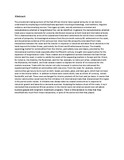Iron working in the Upper Tana valley,Kenya.In Aspects of African archaeology.

View/
Date
1996Author
Mutoro, HW
Herman O, Kiriama
Ngaru, Lazarus
Type
ArticleLanguage
enMetadata
Show full item recordAbstract
The precolonial trading systems of the East African interior have a great antiquity ml can best be understood by employing a multidisciplinary approach including archaeology, oral traditions, linguistic evidence and documentary sources. Two types oj trade, namely subsistence-oriented and nonsubsistence-oriented or long-distance frai, can be identified. In general, the nonsubsistence-oriented trade was a response demands for unevenly distributed resources at both local and international levels, This is demonstrated by some of the coastal and hinterland settlements for which there is evidence for periods of prosperity. Archaeological evidence from the pre-tenth-century AD settlements on the coast, and documentary evidence of the same period, show how this prosperity emanated from trade transactions between the coast and the interior in response to industrial and labor-force demands in the lands beyond the Indian Ocean, particularly the Orient and Mediterranean Europe. The steadily expanding market for commodities from the interior, particularly ivory and slaves, provided by the international maritime trade especially after the fifteenth century, brought new opportunities for the expansion of long-distance trade. These created and strengthened contacts between the East African interior and the coast, in order to satisfy the needs of the expanding markets in Europe and the Orient, for instance, the Akamba, the Nyamwezi, and the Yao caravans, to name just a few, collaborated with the Mijikenda, the Swahili, and Arab caravan traders to deplete tht interior of its resources for the markets overseas. Trade with the interior not only increased in volume but also witnessed the supplementing of traditional commodities with new ones. From the coast, for example, interior communities got luxury items such as cloth, beads, porcelain, glass, and later guns, which had not been seen in the interior before. In addition to these were cowrie shells, now as a form of currency, certain foodstuffs, and salt. These were exchanged for interior products of the hunt and jar slaves. It seems that interior communities never took the first initiative in tk international trade that characterized this region in the period under review. Ik initiative was always taken by coastal communities in response to industrial growth and labor-force demands overseas. Analyzing the balance sheet of this trade, it my k concluded that precolonial African societies in the interior were not what we would now call astute business people with long-term investment programs. There is little evidence to show that they benefited very much from these transactions, in spite of the active role that they played.
Citation
W, PROFMUTOROHENRY. 1996. Henry W.Mutoro, Herman O. Kiriama and Lazarus Ngaru : Iron working in the Upper Tana valley,Kenya.In Aspects of African archaeology. Albert Pwiti and Robert sopur(eds) 1996, pp.505-507.University of Zimbabwe Publications.. In Aspects of African archaeology. Albert Pwiti and Robert sopur(eds) 1996, pp.505-507.University of Zimbabwe PublicationsPublisher
Elsevier Education and External studies
Collections
- Faculty of Education (FEd) [1042]
